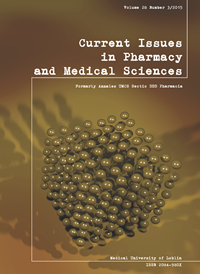The influence of the viscosity of the ointment vehicles magisterial topical preparations, on the speed transfer of biologically active substances
DOI:
https://doi.org/10.1515/cipms-2015-0075Keywords:
ointments, viscosity, viscous elasticity, volatile component lossAbstract
The aim of this study was to analyze the morphological parameters (viscosity, viscous elasticity and the rate of volatile component loss) of salicylic and boric acid-containing magisterial formulae (ointments). Moreover, the effects of these parameters on the diffusion rate of a therapeutic agent (salicylic acid) to an in vitro external compartment were analyzed. Finally, the applicatory properties of the ointments prepared by way of a conventional technique (in a mortar) and with the aid of an unguator, were compared. The rheological parameters of the analyzed ointments suggest that the preparations made with an aid of an unguator, irrespective of the physicochemical characteristics of their vehicles, are characterized by higher values of diffusion coefficient (D). In addition, conventionally-prepared formulae containing salicylic were shown to be characterized by better viscous elasticity. Surprisingly, irrespective of the preparation technique, the ointments based on an absorptive vehicle (containing lanolin) were characterized by similar viscous elasticity. The rate of volatile (water) component loss from ointments containing a 3% solution of boric acid suggests that such formulae lose no more than 2.3% of their mass when exposed at 37℃. Therefore, the viscosity of such ointments applied onto a patient’s skin should remain relatively stable.
References
1. Barlow T., Wiechers J.W.: Measuring Skin hydration. Cosmetics-Toiletries, 114, 47 (1999).
2. Compas P.M.M., Eccleston G.M.: Vitamin A SKIN PENETRATION. Cosmetics-Toiletries, 113, 69, 1998.
3. Fedors R.F.: A method for estimating both the solubility parameters and molar volumes of liquids. Polymer Eng Sci., 14, 147 (1974).
4. Górecki M.: Reologia farmaceutyczna – perspektywy rozwoju. Farm Pol., 52, 739 (1996).
5. Kasperek R.: Czynniki wpływające na process uwalniania substancji leczniczej z postaci leku warunkujące dostępność farmaceutyczną. Farm Pol., 70/2, 105 (2014)
6. Kołodziejska J.: The effect of saccharic alcohols on rheological parameters of dental anti-inflammatory gels and on pharmaceutical availability of sodium ibuprofen. Acta Pol Pharm., 63, 127- (2006).
7. Korhonen M. et al.: Rheological properties of three component creams containing sorbitan monoesters as surefactants. Int J Pharm., 247, 103 (2002).
8. Krasowska H.: Skóra jako droga podania leku. Farm Pol., 10, 561 (1987).
9. Lindenberg M., Kopp S., Dressman J.B.: Classification of orally administrated drugs on the World Health Organization Model list Essential Medicines according to the biopharmaceutics classification system. Eur J Pharm Biopharm. ,58, 265 (2004).
10. Maciejewska A., Kwiecień M., Figiel W., Tal-Figiel B.: Nowe aspekty wytwarzania maści recepturowych. Farm Pol., 68/6, 365 (2012)
11. Maciejewska A., Niwiński K., Jachowicz R.: Nowe rozwiązania w zakresie sporządzania leku recepturowego – czopki. Farm Pol., 66/12, 823 (2010)
12. Marszałł L.: Techniki i procedury w recepturze aptecznej. Biul. Inform., PKOIA 89, 19, 2008.
13. Mitragotri S.: A theoretical analysis of permeation of small hydrophobic solutes across the stratum carncum based on scaled particle theory. J Pharm Sci., 91, 744 (2002).
14. Morizot F., Le Fur I., Tschachler E.: Sensitive skin. Cosmetics-Toiletries, 113, 59 (1998).
15. Piechota-Urbańska M., Kołodziejska J., Zgoda M.M.: Viscosity of pharmacopeial multimolecular ointment vehicles and pharmaceutical availability of a model therapeutic agent. Polim Med., 37, 3 (2007).
16. Polish Pharmacopoeia X, 970(2014)
17. Rieger M.M.: The pH of the stratum corneum and uptake. Cosmetics-Toiletries, 115, 43 (2000).
18. Rinaki E., Dokumetzidis A., Valsami G., Macheras P.: Identification of biowaivers among Class II drugs: theoretical justification and practical examples. Pharm Res., 21, 1567 (2004).
19. Rosada C., Rodrigues L.M.: Solvent effects in permeation assessed in vivo by skin surface biopsy. BMC Dermatol., 3/5, 1 (2003).
20. Sznitowska M., Janicki S., Ruczyńska E.: Wpływ właściwości fizykochemicznych substancji leczniczych na ich wchłaniania przez skórę. Farm Pol., 5/51, 185 (1995).
21. Sznitowska M., Janicki S.: Promotory wchłaniania substancji leczniczych przez skórę. Farm Pol., 7, 391 (1991).
22. Walker R.B., Smith E.W.: The role of percutaneous penetration enhancers. Adv Drug Deliv Rev., 18, 295 (1996).
23. Zgoda M.M., Musiał B., Iwańczyk M.: Wpływ właściwości podłoży hydrożelowych na szybkość dyfuzji niesteroidowych leków przeciwzapalnych do kompartmentu zewnętrznego w warunkach in vitro. Farm Pol., 59, 795 (2003).
Downloads
Published
Issue
Section
License
Copyright (c) 2015 Authors

This work is licensed under a Creative Commons Attribution-NonCommercial-NoDerivatives 3.0 Unported License.


